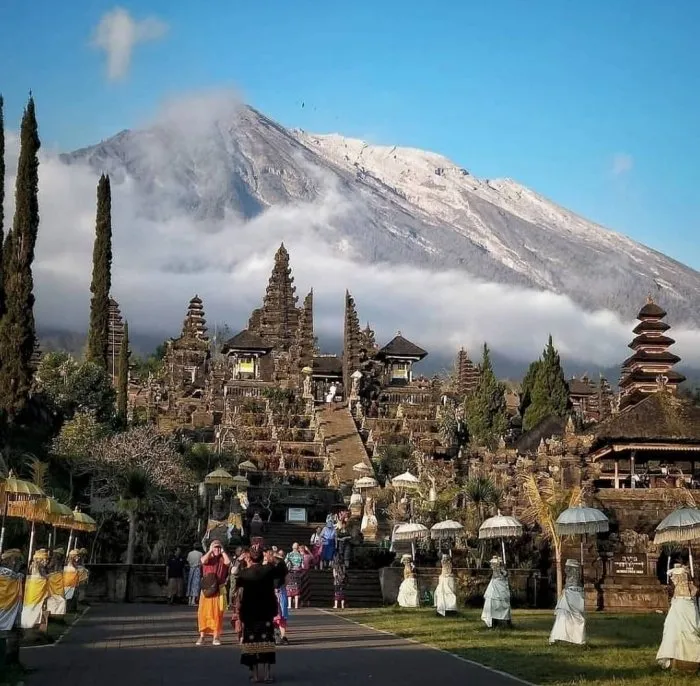If South Bali is known for its lively beaches and North Bali for its waterfalls, then East Bali is where the island’s soul truly comes alive. This region combines dramatic volcanic landscapes, ancient temples, traditional villages, and serene beaches far away from the tourist crowds. It’s a place where you can feel the heartbeat of Balinese culture while surrounded by stunning natural beauty.
Why Visit East Bali?
East Bali offers a blend of adventure, culture, and tranquility. Here lies Mount Agung, the island’s highest and most sacred volcano, towering above rice fields and temples. Traditional villages like Tenganan still preserve Bali’s ancient customs, while coastal towns such as Candidasa and Amed provide peaceful seaside escapes.
For those who want to go beyond the typical Bali experience, East Bali is the perfect choice.
Top Highlights of East Bali
1. Mount Agung
At 3,031 meters, Mount Agung dominates the skyline of East Bali. Considered the spiritual center of the island, it is home to Bali’s most important temple, Pura Besakih. Hiking enthusiasts can attempt a sunrise trek to the summit, where panoramic views of the island and surrounding seas await. For the Balinese, Agung is not just a mountain, but a sacred symbol of life and balance.
2. Besakih Temple
Known as the Mother Temple of Bali, Pura Besakih is the largest and holiest temple complex on the island. Located on the slopes of Mount Agung, it consists of more than 80 temples, with rituals and ceremonies held throughout the year. Visiting Besakih offers not only cultural insight but also breathtaking views of the surrounding landscapes.
3. Tirta Gangga Water Palace
A jewel of East Bali, Tirta Gangga is a former royal palace famous for its maze of pools, fountains, and lush gardens. Visitors can stroll across stepping stones, feed koi fish, or simply relax by the water. The site is both photogenic and tranquil, reflecting Bali’s deep connection with water as a source of life and spirituality.
4. Tenganan Village
Step back in time at Tenganan, one of Bali’s oldest traditional villages. The people of Tenganan are part of the Bali Aga community, who preserve pre-Hindu customs and unique crafts. The village is renowned for its double ikat weaving, a rare and intricate textile art found only in a few places in the world. Exploring Tenganan offers a rare glimpse into Bali’s ancestral heritage.
5. Amed & Tulamben
The eastern coastline is dotted with quiet fishing villages, with Amed and Tulamben being the most popular among divers and snorkelers. Amed is known for its black sand beaches and stunning sunrises, while Tulamben is home to the USAT Liberty shipwreck, one of the most famous dive sites in Southeast Asia. Both destinations offer a laid-back atmosphere, far from the hustle of South Bali.
6. Candidasa
For a peaceful seaside escape, Candidasa is an excellent choice. This small coastal town is perfect for travelers seeking relaxation, yoga, and wellness retreats. It also serves as a base to explore nearby attractions like the Goa Lawah Bat Cave Temple or the traditional salt-making villages along the coast.
7. Sidemen Valley
Often compared to Ubud before tourism, Sidemen Valley is a hidden paradise of rice terraces, rivers, and traditional villages. It’s the ideal spot for trekking, cultural immersion, or simply unwinding amid nature. Many travelers fall in love with Sidemen’s quiet charm, staying in boutique homestays with breathtaking views of Mount Agung.
Culture and Spirituality
East Bali is deeply spiritual, with temples, ceremonies, and sacred rituals forming an integral part of daily life. Unlike the busier south, the cultural practices here feel more intimate and authentic. From witnessing temple festivals to learning traditional weaving techniques, East Bali offers countless opportunities to connect with the island’s living traditions.
Practical Tips for Visiting East Bali
- Getting There: East Bali is about 2–3 hours’ drive from Denpasar or Ubud, depending on your destination. Hiring a private driver is recommended for flexibility.
- Best Time to Visit: April to October offers clear skies, perfect for hiking and diving. November to March brings greener landscapes but more rain.
- Where to Stay: Sidemen for rice terraces and culture, Amed for diving, and Candidasa for a seaside retreat.
- Activities: Hiking Mount Agung, temple visits, cultural tours, diving/snorkeling, yoga, and village treks.
- Who It’s For: Perfect for culture lovers, nature enthusiasts, divers, and those seeking a quieter, more authentic Bali experience.
Final Thoughts
East Bali is a world of its own — where towering volcanoes meet the sea, where history and culture blend seamlessly with daily life, and where the pace slows to let you breathe it all in. Whether you’re climbing sacred Mount Agung, wandering through water palaces, or diving into the depths of Tulamben, East Bali promises experiences that are both grounding and unforgettable.
For travelers who want more than just the postcard version of Bali, East Bali is not just a destination — it’s a journey into the island’s heart.

